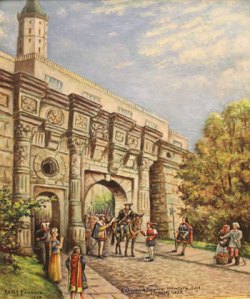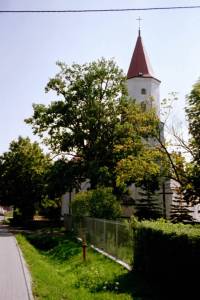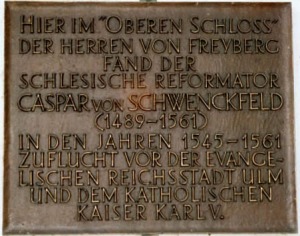OSIEK, POLAND (formerly OSSIG, SILESIA, GERMANY)
During the 1934 Schwenkfelder Pilgrimage, a memorial tablet in honor of Caspar Schwenckfeld had been placed on the side wall of the Ossig Lutheran Church and was unveiled at a memorial service on July 26, 1934. Unfortunately, when the 1972 Pilgrimage with Dr. Jack Rothenberger visited the church, the tablet was missing, whereabouts unknown.
Inscription translation:
In reverent memory of
Caspar Schwenckfeld von Ossig
1489-1561.
A gentle disciple of Christ
A true worshipper of God
A saint in self-denial
A scholar and a prince
in the realm of truth and light
The Schwenckfelders of Pennsylvania
1934.
WROCLAW, POLAND (formerly BRESLAU, SILESIA, GERMANY)
Wroclaw is the capital of Lower Silesia and one of Poland’s oldest cities. In Schwenckfeld’s time, it was a university city and the center of the Silesian Reformation Movement.
LEGNICA, POLAND (formerly LIEGNITZ, SILESIA, GERMANY)
In 1510, Caspar Schwenckfeld was asked to serve as chancellor and spirutal advisor to Duke Frederick II of Liegnitz.

Painting by Adolf Pannash (1929) depicting Caspar Schwenckfeld voluntarily leaving the town of Liegnitz. Courtesy of the Schwenkfelder Library & Heritage Center.
ÖPFINGEN, GERMANY
Schwenckfeld lived many years in the castle of the Freybergs (Oberes Schloss) in Öpfingen. Monies for this plaque installed to the right of the main entrance were collected from the Schwenkfelders in America in the mid-1980s and displayed at a 500th Anniversary of the birth of the reformer Caspar von Schwenckfeld in 1989 by the town of Öpfingen.
Inscription translation of plaque:
Here in the ‘Upper Castle’
of the Masters of Freyberg
the Silesian Reformer
Caspar von Schwenckfeld
(1489-1561)
found refuge
in the years 1545-1561
from the Evangelical
Imperial City of Ulm
and the Catholic Emperor
Karl V
ULM, GERMANY
A fugitive for many years, Schwenckfeld found shelter in his last days in the home of Dr. Agatha Streicher where he died. This home was originally located across the street from the Rathaus (city hall), but the house was destroyed for a new street. It was originally believed that Schwenckfeld was buried in the cellar of the Streicher house, but it has also been speculated that he is buried in the Freyberg family vault (which is sealed) in Öpfingen.

Agatha Streicher home where Schwenckfeld spent his last days. Original painting by Adolph Pannash. Courtesy of Schwenkfelder Library & Heritage Center

Plague commemorating Schwenckfeld placed in 1989.
(500th anniversary of his birth)
Located on north wall of Ulmer Museum, Neue Straße, east of Rathaus (Marketplatz)
Inscription translation of plaque:
Ulm
Caspar von Schwenckfeld
Reformer
Caspar von Schwenckfeld, Reformer, born 1489 in Ossig, Silesia. He brought about from 1535-1539 in his spiritual senses, the committed doctrine of Tolerance and Brotherliness in Ulm. He died December 10, 1561 in the house of the woman doctor Agathe Streicher 10 Longstreet.
This building was destroyed in 1944.
Today New Street runs there.




